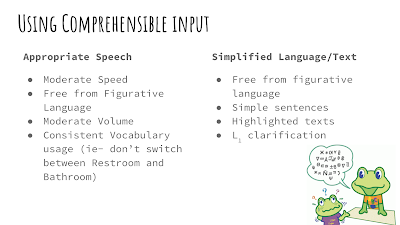I'm sorry for having such a huge gap between my first two newcomer posts, and this one. The end of the school year was just so darn busy! The second tip I shared in the wayback to help you modify instruction for ELLs is to use comprehensible input, so that's what we'll focus on today.
What is "comprehensible input"?
Comprehensible input is a hypothesis of second language acquisition first proposed by Stephen Krashen in the early 80's. The hypothesis states that our ELLs learn and acquire language when they receive input (written or oral) that is only slightly above their current language level (i+1). In other words, the oral and written input we provide students should be mostly understandable, with only a few words or structures that are unknown or new to the student. Students will be able to understand the message, and will acquire new language in the process.
At the newcomer level, comprehensible input is comprised of short, simple sentences, known or learned words and phrases (i), with a few new words or language structures added to get that +1 in the i+1.
This video, while it is foreign language teachers discussing the use of the target language and comprehensible input, is a really excellent illustration of how you can make content comprehensible in the target language for ANY language learner- whether it's a student acquiring English as a second language, or a student acquiring a foreign language.
Why is comprehensible input important?
The image below illustrates about how much a newcomer student might be able to understand when attention is not given to ensuring that the input is comprehensible.
As you can see, the student is really only understanding high frequency words, a few numbers, and some articles and common prepositions. Is the newcomer understanding enough in this scenario to learn new information? Is the newcomer understanding enough to even know what they're being asked to do? At best, we can tell that it seems like some sort of math problem.
When the input a newcomer receives is not comprehensible, they're likely to simply shut down. When the student shuts down, no further learning is possible- of language or content.
How can I make the input I provide to my newcomers comprehensible?
There are many ways to ensure that the input you provide your students is comprehensible. The image below shows a few.
You can also provide visuals with oral or written input (visuals, visuals, visuals!). In one of the schools that I worked with this past year, the ESOL department chair created a shared Google Drive folder, with subfolders for subject area and topic. As the teachers went through the year and taught certain topics, they added images from Google and elsewhere to the shared folder. Since many topics span grade levels, it was easy for teachers who needed images for a topic to find what they needed to enrich learning and make input comprehensible. The teachers still continue to build and use this shared resource of visuals for their ELLs.
Another great way to make oral speech comprehensible is to use a lot of gestures and body language, or to even act things out for and with students.
Making input comprehensible does not mean "dumbing it down".
Its important to remember when you focus on comprehensibility that you are simplifying the language, not simplifying the content. It is possible to convey complex ideas in simple language, especially if you are using appropriate scaffolds and supports, as discussed last time!








No comments:
Post a Comment